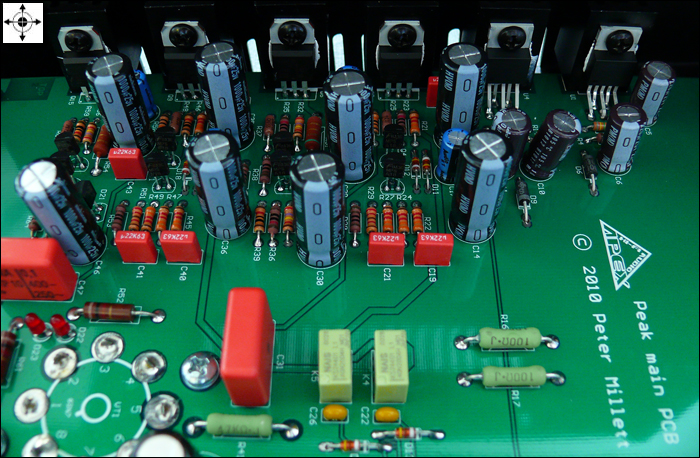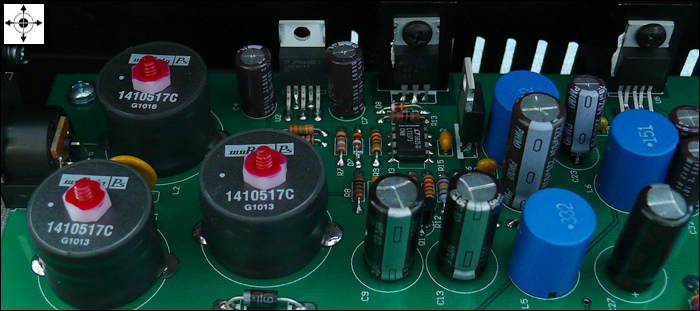This review page is supported in part by the sponsors whose ad banners are displayed below |
 |
 |
Under the head unit's hood, circuit designer Pete Millett's name is proudly immortalized on the inverted board. His DIY audio pages are popular with headfiers and his former company had commercialized two headphone amps. Pete and Todd go back to HeadRoom where Todd worked for 9 years and Pete contributed to engineering. Or as Pete put it, "as a life-time electronics geek I got a ham radio license at the age of 8 and a first-class commercial radio license at 14. I'm just old enough to actually have built and used tube stuff when it was still in production. I've been an electrical engineer for nearly 30 years doing mostly computer and consumer electronics design work. For a few years I've owned and operated Wheatfield Audio which made tube headphone amps (but no money!). On occasion I've also written articles for AudioXpress magazine, formerly Glass Audio. I do some commercial audio design work outside of my day job which currently is for a large semiconductor company [Texas Instruments - Ed]."
|
 |
As the upper photo shows, the relay-switched i/o RCAs are properly chassis mounted as though expecting plenty of abuse from super-grippy connectors. With six heat-sinked parts against one cheek—four Mosfets, two per channel arranged as source follower and current sink, plus two National Semiconductor LM2941T voltage regulators—and on the other cheek three more heat-sinked bits plus two regulators (all power related, with the regulators generating the HV and filament voltage for the tube plus a housekeeping rail for relays, LEDs etc.),
all the heavy-duty capacitive filtration and reserves for the Peak are housed offboard in the Volcano.
|
 |
The next closeup shows three small common-mode chokes from the corporate giant who also manufactures the fantastic muRata gold piezo super tweeter as seen in speakers by Vienna Acoustics and MicroPure. These mostly help to decouple HF noise from the stock SMPS.
|
 |
Pete Millett on his Apex circuits: "The Peak is a 2-stage amp with the 6SN7 providing voltage gain and a single-ended Mosfet output stage. The amp does invert phase. I believe this is preferable to adding an extra active stage just to flip the phase. The Peak
delivers about 5Vrms into 32Ω and 8Vrms into 150Ω or higher. Peak output current is about 220mA.
The Pinnacle is also a 2-stage amp using a 6SN7 capacitively coupled to the PX4. The input and output are electrically balanced and coupled through transformers but the amp is single-ended. It is capable of driving close to 10Vrms into 32Ω or higher. The manufacturing cost difference between the Peak and Pinnacle is enormous. For example the two output transformers in the Pinnacle amp alone cost about the same as the entire bill of materials for the Peak."
|
|
|
The Volcano power supply puts a Schaffner FN 405-3/02 single-phase choked-based line filter right behind its power IEC. The Alfamag power toroid from Texas runs ±12V secondaries. There's a total of fourteen 25V/22.000uF electrolytic capacitors for what would seem dead-serious capacitance given this low-voltage application.
|
 |
This really is quite overkill but fully in sync with the longstanding truism that audio signals are nothing but modulated power supplies. Upgrade the power supply, upgrade the signal. Here's how Todd the junkie describes his fix on Pete: "Apex HighFi Audio is the combined work of Pete Millett and I. Pete is the design engineer who makes magic happen inside the box. It's entirely his design skill we rely on. I have product ideas—as does Pete sometimes—and present those to him. Pete designs, I listen and we go from there. We have worked together to produce some TTVJ products like the TTVJ 307A, TTVJ Millett Hybrid portable, TTVJ Slim, TTVJ FET-A and the TTVJ Hybrid Phono Stage. Some of these are still in production and the TTVJ Slim is a very popular portable at this time. It will also be the last TTVJ product we do as all new adventures will be done under the Apex line.
|
 |
"The Apex lineup started with the Pinnacle. It was an all-out assault on a combination preamp/headphone amp. My desire to have a top-line preamp in my own system along with a top-line headphone amp was the driving force behind that project. The Pinnacle did not disappoint and out of that work came the Peak and Volcano. This was a tougher challenge for Pete. Here he was under a cost restraint unlike with the Pinnacle. But the Peak and Volcano may just be some of his best design work. With a limited expense account Pete delivered an excellent preamp/headphone amp and power supply. Though the Pinnacle is superior, the Peak and Volcano deliver a lot for the money.
|
|
|
"We elected to use an inexpensive 6SN7 expecting the end user to buy the 6SN7 of his/her choice. There are so many great 6SN7s with so many flavors that choosing one was not really an option. So the TungSol was picked for the stock tube to keep the expense of the amp down. I included the Shuguang as I feel it is a good new stock tube that is current and available. But the NOS tubes out there will really make the Peak shine. I hope you have some 6SN7 tubes of your own or at least access to some. The one thing the Peak will do is allow the input tube characteristics to come through in the output. Basically the tube provides the sonic signature while the amp is a black background for the music. Aside from all standard 6SN7s any true VT181 is allowable as well [though called a VT181, consensus on the black Shuguang seems to be that it's mislabeled and really a 6SN7 - Ed]."
|
 |
  |
 |